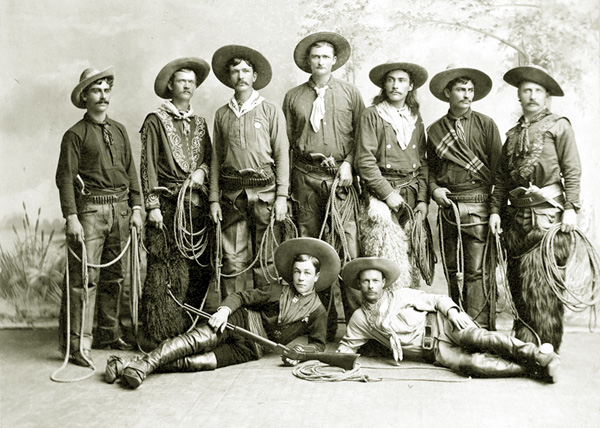
Some of the Cowboys in the Wild West show, approx, 1887.
Left to Right: Joe Esquival, "Chief of the Cowboys and bucking bronco rider; Jim Kid (James Willoughby), bucking bronco rider and roper; Jim Mitchell, bucking bronco rider;
Dick Johnson, bucking bronco rider; Billy "Coyote" Bullock; bucking bronco rider; Tony Esquival, bucking bronco rider;
Tom Duffy, bucking bronco rider;
Font row, lying down: Johnny Baker, "The Cowboy Kid," sharp shooter and bucking bronco rider; Bill Johnson, Pony Express rider.
Initially, the stars of shows such as that of Buffalo Bill's Wild West were all "real" cowboys such as Buck Taylor discussed on the
preceeding page. Anotoher of the more popular cowboys associated with Wyoming in the
1890's and early 1900's was Jim Kid (Willoughby) (1856-1916). Although many writers spell his name as "Kidd", Jim spelled the name in personal correspondence as Kid." Census information for 1880 refects that he was born in
Arkansas. Kid told Harry Gant,
an old time cowboy from from the plains of
northern Colorado and southeastern Wyoming that he was born on the plains near Cheyenne. See Gant, infra, p. 203, perhaps on the old Willoughby Ranch on Crow Creek.
At last two sources have been found indicating that he may have been born in Texas. Neither gives a source.
Gant, himself, had wandered from being a cowboy, to being a stock producer for western shows, and finally to being a camera man and director of early
silent western movies. See Gant, Harry Arthur: "I Saw Them Ride Away," Castle Knob Publishing, 2009.
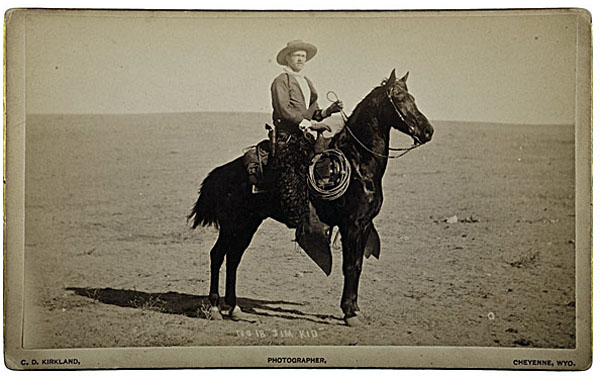
Jim Kid, photo by C. D. Kirkland.
Little is known of Kid's life prior to about 1880. The 1880 census for Cheyenne indicates that at that time, Kid, along with his
sister was living with his maternal grandmother in Cheyenne. Other records reflect that he was employed in that same year on the
Philip and James Dater's "Y Cross" ranch north of Pine Bluffs along Horse Creek near present-day LaGrange. According to Fritz Thayer he also rode for
F. E. Warren's ranch along Crow Creek. See Billboard December 25, 1909, p. 20. Thayer in the late 1800's and early 1900's was a prominant newspaperman,
world traveller and adventurer. According to the Tammany Times he was 'among the prominent young men in New York, or the United States for that matter, none are better or more favorably known than Frank C., ordinarily known as 'Fritz' Thayer.“ Fritz" was in the theatrical business,
, prominent in politics during the campaign of 1888 in St. Louis, had several business enterprises of importance on hand, which, one
writer noted that Thayer "would have commanded him a good future had he stuck to them; but ambition and energy carried him into other fields" He traveled the
greater part of the world, and has "made a reputation for himself as a
contractor in the ruby mines of Peru and on the Isthmus of Panama; as a
theatrical schemer in the West India Islands; and has also handled
enterprises of various kinds from Pictou, Nova Scotia, to San Francisco, Cal."

"Y Cross" brand of the Dater Brothers' Sixty-Six Ranch.
The Daters were the very affluent sons of the third largest grocery provisioner in the United States, a kind of
Sisco of the time. They arrived in Cheyenne in the late 1870's and established several ranches along Horse Creek and Bear Creek. The Dater
Brothers were founders of the Cheyenne Club. Philip was its first president.
Grant Lee Shumway (1865-1925) in his 1921 "History of Western Nebraska and its People,"Western Publishing & Engraving Company, Lincoln, 1921, Vol 2, P. 113,
attributed Kid's subsequent riding and roping skills to that learned on the Y Cross and from its then manager
Ben Morrison. Ben developed an aversion to suspected rustlers. The aversion placed Morrison on the rolls of infamy.
Professor Larson, History of Wyoming, 2nd Edition Revised, University of Nebraska Press, p. 189, devotes one paragraph
to Morrison:
Goateed Detective Ben Morrison submitted this laconic report in
1880: “Febr. 13: Left to arrest J. J. McGinnis, captured him at Fort
Laramie. On the trip to Cheyenne he attempted to make his escape and
Met his death. Arrived in Cheyenne February 20." A coroner's jury
decided that McGinnis really had been trying to escape when he was
shot. After two soldiers who had been close by, though not eyewitnesses, said they thought it was murder, the widow accused Morrison of
murder but was unable to convince a grand jury.
Subsequently, Morrison participated as an "invader" in the Johnson County War.
Two incidents led to Kid's subsequent fame: (a.) a winning ride in 1884 where he received the appellation of
"Champion Rider of Montana" used subsequently in publicity for the Wild West show and (b.) a ride of a wild
Irish Stallion in Paris.
The Daters' Y Cross went through a series of owners and ultimately became a part of the Yoder Ranch in Goshen County.
In 1884 in Montana, Kid entered and won a bucking contest riding a horse named
"White Emigrant." The prize, besides the title
"Champion Rider of Montana", was a Meanea saddle and other gear which
Kid retained for the rest of his life. Meanea gear was highly regarded. Nora H. Dunn, in "Frank A. Meanea, Pioneer Saddler," 26
Annals of Wyoming, p. 25 at p. 26 (1954) noted:
The Meanea shop sign and the windows behind it have been. the mecca of youthful longings throughout the
length and breadth of the rangeland. To desire a Meanea saddle betokened
ambition and a highly placed goal. To own a Meanea saddle was the mark
of achievement and the reaching of that goal. To own a complete Meanea
outfit placed one on a superior plane in the eyes of others and lifted
the owner to the level of a seventh heaven.
The winning ride resulted in
employment by Cody who was then organizing his Wild West show.In 1886, Col. Cody purchased
White Emigrant and had the horse shipped from California to Cheyenne care of Willoughy. The horse was to be ridden by
Willoughby in the upcoming season.
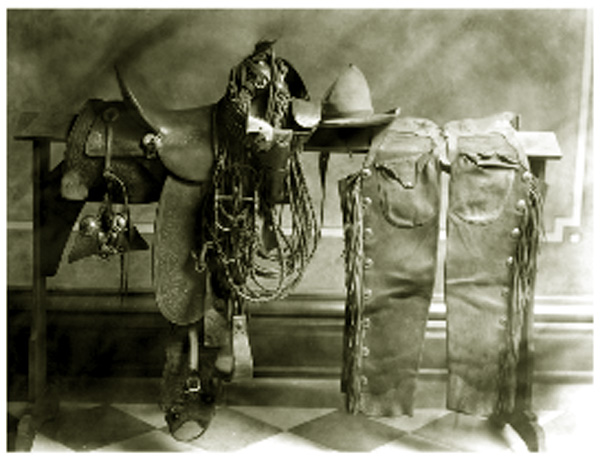
Jim Kid's Meanea and other gear in the State Capitol Building near the governor's office approx. 1925.
As discusssed further below, the gear depicted was donated to the State Museum following Kid's death.
The win in Montana, however, may not have been Kid's first. Publicity pieces in the 1890's for his own western show claimed that he won a bucking contest in
Humboldt Wells, Nevada, in 1882. See Durham [North Carolina] Globe, August 31, 1893, p. 2. He may have been competing even earlier.
See Rowdy Waddy's column, "The Corral" in Billboard,
Feb. 19, 1916, p. 23. For discussion of Mr. Waddy see
Frontier Days
On September 28, 1886. the Wild West Show was on Staten Island. There in Buck Taylor's tent with Buck acting as best man,
Kid married one of the show's prominent sharp shooters, Lillian Frances Smith, the "California Girl." The marriage was dutifully reported the next day by the Brooklyn Union, p. 4. The marriage
ended when Smith ran off with Bill Cook one of the cowboys in the show.
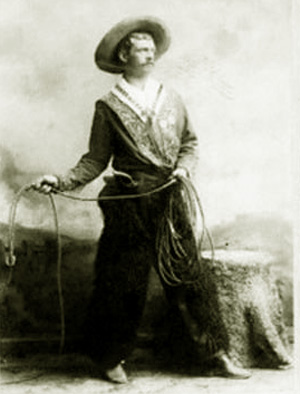 
Left:Jim Kid, approx., 1886, Right: Lillian Frances Smith, approx. 1886
In 1887, Col. Cody's Wild West toured of England in conjunction with Queen Victoria's Golden Jubilee. During the performance at Earls' Court, Her Majesty asked if she could see
Kid's gear. He handed it, including his gun, to her for inspection. The tour was such a success that Col. Cody repeated and expanded the tours in the following years.
In 1889, the Wild West performed in Paris. There some members of the Jocky Club expressed the thought that Col. Cody's broncos were broken down nags and the cowboys were not that good.
They bet Col. Cody that they had a horse that could not be ridden. Jim Kid and Joe
Esquival vied for the honor of riding the unseen horse. Kid was to be the first to try. Out came an Irish stallion on which two men had been killed in a prior attempt.
The New York Herald, July 7, 1889, Sextuple Sheet, p. 13, and other papers described what happened. The following is the version picked up by the
the Breeder'Gazette, April 9, 1890:
The following interesting account of the prowess of the American cowboy
exhibited in the taming of vicious horses was cabled some time since to
the general press by a Paris correspondent:
There was an unusually large attendance at a recent performance at
Buffalo Bill's Wild West Show. A large proportion of those present
had been attracted to the camp by an announcement that the equestrian
skill of Col. Cody's cowboys was to be put to the test in riding vicious
French horses of which they knew nothing whatever. Certain Parisian
gentlemen who fancied that the exhibition of bucking horses was conducted
with animals trained to display the wildness that had long before been
taken out. of them, laid heavy wagers with other members of the Jockey
Club who had confidence in the genuiness of the bucking-horse act that
they could produce an animal which the cowboys could not saddle, bridle,
and ride in the time usually devoted to that portion of the performance.
The horse selected was Le Retif, is powerful black stallion 17 hands
high. belonging to M. Taillard, that had acquired a well-merited reputation
for viciousness by killing two men who had attempted to break him into
saddle and bridle. He was not brought to camp until a few minutes
before the commencement of the performance, and when the time came
for the bucking of horses he was turned into the arena along with the
bronchos and other horses used in the act. He had not gone far before a
lasso thrown by Tony Esquival settled around his neck, and the novel
experience was such a surprise that he offered no serious resistance to
being saddled and bridled. Then be apparently realized the situation, and
while the usual bucking business was progressing he made things
particularly lively for those that were holding him. After five or six of
the bronchos had been ridden Le Retif was led forward, and before he knew
what was to be done with him, Jim Kid, the Wyoming cowboy, was on his
back. For a few minutes Le Retif showed that in the art of bucking he
had nothing to learn from his American brothers. He alternately pawed
the air with fore and hind feet, gave great leaps, and did his level
best to unseat his rider, but all in vain, and presently he gave up the
struggle and allowed Kid to put him through his paces around and around
the arena, while the delighted audience rose to its feet cheering and
waving hats and handkerchiefs with wild enthusiasm. Presently Kid pulled
up and another cowboy got on behind him, and Le Retif after a brief
struggle was forced to carry a double load around the arena. M. Taillard
was the first to declare that the performance was a magnificent spectacle
of equestrian skill, and the disappointed backers of Le Retif, although
they had as much as 50,000 francs at stake on him, did not attempt to
claim a fine. Even the other horses seemed to enjoy the scene. Breeder's Gazett
, April 9, 1890.
For at least the next sixteen years, the story was repeated almost verbatum by publicists for the
various wild west shows in which Kid appeared. See e.g.Los Angeles Herald, January 17, 1906, p. 2., and the
Albuquerque Morning Journal, July 1, 1906, p. 9. In the later, however, he was advertised as
the "Champion Bronco Rider of the World." See also Los Angeles Herald, January 21, 1906, p. 7, where is is shown as the
"champion rough rider of the world."
Kid left the Buffalo Bill show and started his own Wild West show which performed at various county fairs.
He later appeared in Doc Carver's show, the Washburn & Arlington Shows, and joined the Miller Brothers 101. While with the Miller Brothers he sustained
"brain fever" from which he was "not expected to live." "Brain fever" was a term used in the late 19th and early 20th Centuries for an inflamation of the brain which could arise from a
number of causes.
With recovery and in the face of decline of wild west shows, Kid drifted to Hollywood wheree played minor parts in
"Birth of a Nation" and "Jordan is a Hard Road." In the latter movie, Fred Burns from Cody, Wyoming, who previously broke horses for Col. Cody's TE Ranch, also played a minor part.
With age and injuries, Kid fell into hard times. By 1914, Kid and his cowpony "Joe" were acting as "extras" and doing "shorts" for the standard rate of
$5.00 a day combined ($3.00 for Kid and $2.00 for Joe). See Weekly Underwriter, December 5, 1914. On May 23, 1914, while flming he went off a cliff.
He managed to save Joe from injury, but
At first, according to newspaper reports he was not expected to surive.
Kid had a dislocated shoulder, three broken ribs, ruptured cartilage of a knee and fifteen stitches. He was laid up for eighteen weeks.
Apparently, Kid developed a persistent "cold" which he attempted to self-medicate with whiskey. On December 9, 1916, Jim Kid in Harry Gant's words, "
"cashed in his chips." Like many who are on a losing streak, the chips were sparse, his Meanea saddle an gear, his dog Pinocle, his faithful cowpony Joe -- and a fifty cent piece which the undertaker found in his
clothes. Fred Burns who had known Jim in the good times started to pass the hat to pay for a funeral. Perhaps, sensing that soon he would cross the Great Devide,
Jim had told Harry that he would like to be buried out on the
plains near Cheyenne. Douglas Fairbanks told Fred to put his hat away. He would pay all expenses. Fairbanks regarded Kid as an old friend. Kid and Fred Stone had taught Fairbanks how to rope. Kid had taught
Fairbanks how to throw a double knot. Kid, Curly Baldwin, "Smokey" Peterson, Fred Burns and Eagle Eye had gotten together and had presented
Fairbanks a cowboy outfit. Kidd had taught Bessie Love, later a well-known film star, how to spin a rope.
For discussion of Fred Stone, see < Frontier Days.
Harry looked for a church in which to hold a funeral. Al Jennings, a former lawyer from Oklahoma, who turned to robbing trains after a shoot out with
another lawyer, was to deliver the eulogy. Jennings had reformed and became a cowboy movie star. Harry was turned down by six churches. Harry came across a seventh church, a very large church Mediteranean Revival structure
on the northeast corner of 6th and Hill, across from Central Park. It was one of the largest churches in the
city. The sanctuary could seat 1500 parishioners. It boasted of a 38 rank organ.
Other churches had declined to comfort those who morned a poor, forgotten cowboy. Harry may have thought to himself what chance would there be
for such a magnificent church to permit words to be said on behalf of Jim by a former outlaw.
Harry almost passed it by, but nevertheless talked to the minister, the Reverend Dr. Charles Edward Locke, later a Methodist bishop, who after hearing the story agreed and said, "no charge." Thus, Jim was sent to
Cowboy's Heaven from one of the largest and richest churches in Los Angeles.
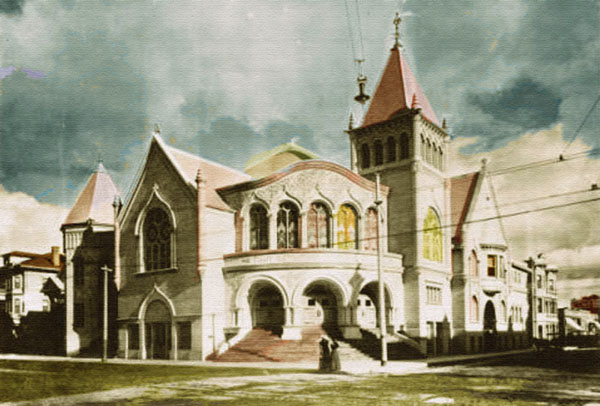
Los Angeles 1st Methodist Church, approx. 1900.
The Church was razed in 1922. The organ was broken up and sold for parts. Central Park was renamed Pershing Square in 1918.
Pall bearers in Los Angeles included were Douglas Fairbanks, William Gottinger, Vestaet Pgg, Harry Carey, Fred Burns, Harry Burns, Harry Gant and Bud Osborne. See Cheyenne State Leader, December 17, 1916, p. 1. In the same issue, the
paper reported that Buffalo Bill was seriously ill at the home of his sister in Denver. Doug Fairbanks later
estimated that the funeral cortege consisted of 250 horses and riders. See State Leader, August 18, 1917, p. 6. The cortege was led by
Joe, with Kid's boots in the stirrups reversed. Joe was followed by an old horse drawn hearse.
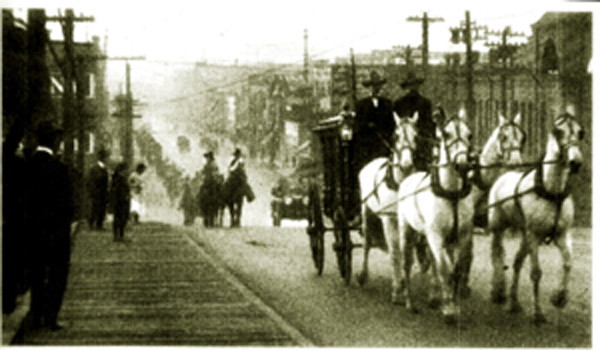
Jim Kid's funeral cortege led by Al Jennings and Douglas Fairbanks on
horseback.
According to a correspondent in the Ithaca [New York] Journal, December 28, 1916, p. 3, Jennings' eulogy brought tears to the eyes
of hardened cowboys.
Kid's dog, Pinochle, broke loose at the church and followed the horses and riders to the railway station.

Jim's cowpony Joe and cowboys bid Jim Goodbye at the Los Angeles Railway
Station.
Joe was adopted by Fairbanks. At the station, the dog could be heard wimpering in the bushes.
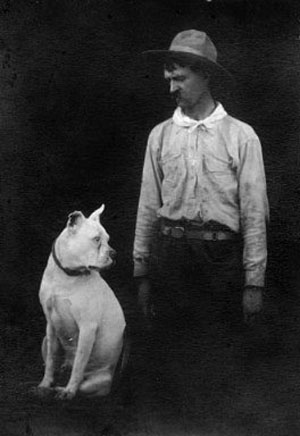
Jim Kid with Pinochle, undated.
At the station, Jim's gear was placed in a box and was also shipped to Cheyenne. Harry Gant had telegraphed Charles Hirsig asking him to make arrangements in Cheyenne.
Hirsig was one of the founders of Frontier Days and was active in arrangements for the Rodeo each year.
He was a stockman who raised polo ponies at the Polo Ranch about eight miles northwest of
Cheyenne. The Frontier Days committee made arrangements for the funeral with Clyde Early Undertaking Rooms at 1717 Capitol Ave.
Pall bearers were
Percy Hoyt, George Gilland, Frank Meanea, Warren Richardson, Charles W. Hirsig and Harry Hynds.
See State Leader December 22,1916, p. 8. The Service was conducted by the Reverend Dr. George Rafter of the Episcopal Church.
[Writer's note: Harry Gant was under the impression that the Cheyenne Elks Lodge made the arrangements. Hirsig was an officer in the Lodge as well as
an important with the Frontier Days Committee]
.
The grave was orignally marked with a temporary wooden marker. Cowboys from a James Cruze movie crew were in Cheyenne. [Writer's note: Probably the movie
"Pony Express" which was shot on Charley Irwin's ranch] decided to visit Kid's grave and discovered the wooden marker. They decided that they would pass the hat
themselves and not ask any of the big stars. The stars whould undoubedly pay for a suitable marker themselves, but the cowboys
wanted to do their own tribute from Kid's old friends. With contributions from
$1.00 to $10.00 the money was raised. See Queens Borough [Long Island] Daily Star,
August 17, 1925, p. 2.
Jim's grave marker reads:
_________________
JIM KIDD
COWBOY
1856-1916
FROM HIS FRIENDS
_________________
Following, the seperation of Kid and Lillian Frances Smith, Smith continued her career as a sharp shooter. She, however,
changed her persona to that of a native American Sioux known as "Princess Wenona." In addition to
appearing in her own show, she appeared in Pawnee Bill's show and later in the
Miller Brothers' 101. In the 1920's Miller Brothers' failed, but she continued to live out her remaining years in a small
cabin at the 101 home ranch at Ponca City. On February 6, 1930, a short obituary appeared in the
Ponca City News:
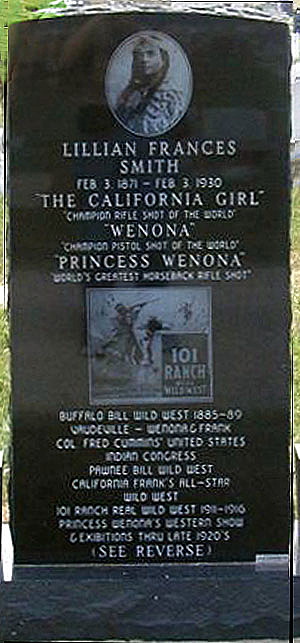
Indian Circus Queen Is Buried at Ponca City Of Ponca City Portrait, Rifles of Wenona are Given to Historical Society of State
Ponca City, Feb. 5-Special- Funeral services for Princess Wenona, Indian woman, for a score of years queen of the sawdust ring and for 40 years a champion rifle shot, were held from the First Christian Church here Wednesday. Burial services were held at the Ponca City Cemetery.
There were no relatives of the famous Indian woman present but many who had known her during the last ten years of her life and a scattered few who had associated with her during her circus career were there. Rev. G. Frank Sanders officiated the rites.
One of the final requests of Princess Wenona in her will was that she be buried under her maiden name of Lillian Smith, and this was done.
She had designated Arthur Rynearson, druggist of Marland, as her administrator and her will is to be probated at Perry February 17. She was 59 years old.
Among the bequests of Princess Wenona is the following list of her personal effects which are to be given to the State Historical Society.
One life size portrait of Princess Wenona, world's greatest horseback rifle shot. One beaded surcingle. One beaded blanket. One pair silver-plated spurs. One ermine trimmed buckskin squaw dress. Four Winchester carbine rifles, 44-40 calibre. Two gold-plated Winchester rifles, .22 calibre. One gold plated Smith and Wesson revolver, .38 calibre. One bullet proof vest.
Records, which Princess Wenona left, show that she started as a rifle shot at 9 years of age, and that she joined the Buffalo Bill show as an expert in 1886, and that she later was with the Pawnee Bill and the 101 Ranch Wild West shows, finally retiring from show life in 1920. She had called Oklahoma her official residence since 1907. She was presented to Queen Victoria of England, and personally met and shook hands with 140 members of royalty. It was in 1887 that Buffalo Bill
offered $10,000 to anyone who could defeat her as a rifle shot.
The graveside funeral was sparcely attended. There were no relatives. Few present knew Princess Wenona from her glory days more than ten years before.
Zach Miller was away, His two brothers were dead. Col. Joe Miller died of Carbon Monoxide poisoning in 1927. George was killed in an automobile
accident a year before on February 2, 1929. The Assistant Ranch Manager Will. A. Brooks was in charge. It was a chilly bleak day, as only northern Oklahoma can be.
Four cowboys, Brooks, and a newspaper reporter acted as the pallbearers. As the coffin was being lowered, the clouds parted and a
ray of sunshine illuminated the grave.
For many years, the grave marker could not be found. It was believed that she had been buried in an unmarked grave. For five years members of the 101 Old Timers Association searched for the grave.
In 1999 a small simple cement marker bearing the inscription, "P WENONA," was found under six inches of soil apparently accidently buried when a near by grave was dug and then
further covered with an accumulation of grass. the four-foot high grave marker depicted above was placed by the Old Timers.
Writer's note: The lesson to be learned is do not put directions as to funerals or arrangements only in a Last Will.
Typically, wills are not read until after the funeral. Franklin Roosevelt's will requested that he no be embalmed.
The direction was found only after it was too late.
Music this Page:
The Last Great Roundup
Traditional
Courtesy Horse Creek Cowboy
Last night as I lay on the prairie,
I gazed at the stars in the sky.
I wondered if ever a cowboy
Would land in that sweet by and by.
They say there will be a great round-up,
Where cowboys like dogies will stand,
To be cut by the riders from heaven,
Who are noted and know every brand.
The road that leads down to perdition
Is narrow and dim so they say.
And the road that leads up to God's Kingdom,
Is staked out and blazed all the way.
I wonder if ever a cowboy,
Would prepare for that great judgment day,
Could say to the boss of the riders,
"I'm ready to be driven away."
They say we will never forsake you,
For He knows every action and look.
So for safety you 'd better be branded,
And have your name in the old Tally book.
Writer's note: References to the "Last Great Roundup" have been found dating to
1895. The song likens cowboys to mavericks being rounded-up by Heaven's angels. On roundup, each wagon mainained a "Tally Book" identifying each
maverick branded so that at end of roundup each wagon would receive credit for each calf to which they were entitled. Emerson Hough
explained:
If after the roundup a rancher finds a neighbour's calf unbranded,
but following the cow upon his own range, he brands the calf with the
owner's proper brand, and not with his own. This is simply a matter of
individual honesty. The cowman knows that his neighbour will do as much
for him. Each ranch keeps its own separate tally-book in this way, and
these are exchanged at the end of the season, so that each man gets what
belongs to him, no matter where it may have wandered, and no matter
whether he ever sees it again.
Next page, The last years of William Cody.
|